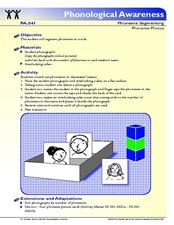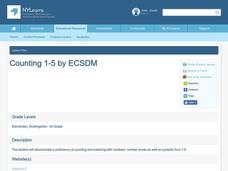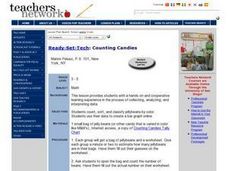Florida Center for Reading Research
Phonological Awareness: Syllables, Clapping Names
Scholars practice identifying and counting syllables. Images of classmates are cut out and placed on a chart. Learners clap and count the syllables in each child's name. They finish by writing the number of syllables under the...
Florida Center for Reading Research
Phonological Awareness: Phoneme Segmenting, Phoneme Photos
This great activity incorporates counting, phoneme segmenting, and class photos. In pairs, learners take turns saying, counting, and checking the number of phoneme segments found in their classmates' names. They count the phonemes and...
Annenberg Foundation
Geometry 3D Shapes: Euler's Theorem
How do you get a theorem named after you? Euler knows what it takes! The third lesson of five asks pupils to use an interactive activity to compare the faces, vertices, and edges of seven different three-dimensional solids. They use...
EngageNY
The Opposite of a Number
It's opposite day! The fourth installment of a 21-part module teaches scholars about opposites of integers and of zero. Number lines and real-world situations provide an entry point to this topic.
Curated OER
Equal Groups of 5 practice 19.7
In this dividing by five worksheet, students use arrays to write division sentences and solve a word problem. Students write answers to five problems.
Curated OER
Counting to Five
In this math worksheet, students count the numbers of stars in each box. They connect pairs of boxes that have identical numbers of stars by drawing a line between them.
Curated OER
Equal or Not Equal
Tiny mathematicians count the number of shapes (up to 8) in pairs of object groups and identify the sets as equal or not equal. Five practice problems. They also draw 2 groups of shapes that are not equal. A focused tool that...
Curated OER
Naming the Pattern
In this pattern activity, 2nd graders complete fifteen number patterns and explain the counting pattern for each group. Students also complete five picture patterns and label each of the patterns.
Curated OER
Understanding 10: Backwards and Forwards
Help your young mathematicians completely master 10 by practicing one-to-one correspondence, number recognition, and recording numbers displayed. They make 10 with groups of two-different colored cubes and color in 10-frames to show how...
Curated OER
Counting 1-5
Students explore numbers by participating in basic counting activities. In this early math lesson, students identify the numbers between 1 and 5 and read several books that demonstrate early counting. Students practice counting to 5 on...
Curated OER
Grade 1 Math Practice
In this counting coins worksheet, students answer 5 fill in the blank questions where they count groups of nickels and pennies and write the amount of money pictured on the line provided.
Curated OER
Grade 1 Math Practice
In this counting coins worksheet, students answer 5 fill in the blank questions where they count groups of nickels, dimes and pennies and then write the amount of money on the blank provided.
Curated OER
Count On It!
Young scholars investigate money. In this consumer math lesson, students use coins, identify their value, then group them in various ways to equal a dollar.
Curriculum Corner
Valentine Math and Literacy Practice
Looking for math and literacy practice with a Valentine's Day theme? Look no more, because this 43-page packet is filled with practice pages intended to reinforce basic math, reading, and writing skills. From counting to writing words to...
American Statistical Association
Happy Birthday to . . . Two?
How many people do you need in a room before two likely share the same birthday? Scholars consider this puzzle by analyzing a set of data. They ponder how to divide the data and determine the proper size of a group for this event to...
EngageNY
Real-World Positive and Negative Numbers and Zero
Class members investigate how positive and negative numbers are useful in the real world. Individuals first read a short passage and identify terms indicating positive and negative numbers. They consider situations involving positive...
Overcoming Obstacles
Identifying Your Learning Style
How many different learning styles are there? Four? Five? Seven? Twelve? It depends on who you ask. But the point of this lesson is that people learn differently, and most have a way or ways that work best for them. To help identify...
EngageNY
Finding a Rate by Dividing Two Quantities
Develop the right station to solve rate word problems. The 18th instructional activity in a series of 29 starts by interpreting the aspects of rates with two different quantities. Pupils use the interpretation of rates to solve problems,...
Curated OER
Anchoring Numbers to Five and Ten
Students complete activities to relate numbers to each other. In this number connection lesson, students count number sets, count forward and backward, and complete other number recognition activities to learn how numbers are related.
NTTI
Putting Together Ten
Groups explore sets of 10 items in two varieties (i.e. 3 white buttons and 7 black ones, or 5 bears and 5 bunnies). They brainstorm about their objects, write math sentences to represent what they have, and report their discoveries...
Alabama Learning Exchange
"Nuts" about Peanuts!
Learners describe the characteristics of a peanut and peanut butter using their five senses. They record their observations and descriptions on a graphic organizer. They may use the Internet to look up answers to questions about peanuts...
Curated OER
Come Together!
In this counting groups worksheet, students draw a circle around the groups of animals. Students count the number of animals in the groups and write that number on the line.
Curated OER
Arrange in Ascending Order
In this number sense learning exercise, students practice arranging sets of numbers in ascending order. Students arrange five groups of numbers and write them down in the correct order.
Curated OER
Counting Candies
Students count, sort, and classify jellybeans by color. They use their data to create a bar graph. Students are given a small bag of jellybeans, and a worksheet on Counting Candies Tally Chart. They work in small groups. Students are...























